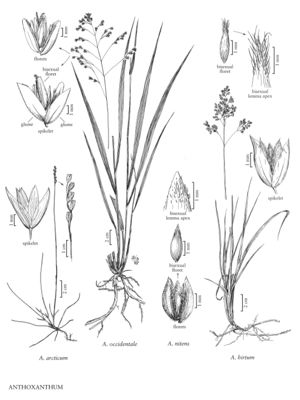Difference between revisions of "Anthoxanthum occidentale"
imported>Volume Importer |
imported>Volume Importer |
||
| (One intermediate revision by the same user not shown) | |||
| Line 41: | Line 41: | ||
|publication year= | |publication year= | ||
|special status= | |special status= | ||
| − | |source xml=https:// | + | |source xml=https://bitbucket.org/aafc-mbb/fna-data-curation/src/200273ad09963decb8fc72550212de541d86569d/coarse_grained_fna_xml/V24/V24_1081.xml |
|subfamily=Poaceae subfam. Pooideae | |subfamily=Poaceae subfam. Pooideae | ||
|tribe=Poaceae tribe Poeae | |tribe=Poaceae tribe Poeae | ||
Latest revision as of 16:21, 11 May 2021
Plants perennial; loosely cespitose or the culms solitary, rhizomes elongate, 1-3 mm thick. Culms (4)60-90 cm. Sheaths scabrous to scabridulous; ligules 1.5-4(6) mm, rounded to truncate; blades 20-40 cm long, (3)5-15 mm wide, flat, rather stiffly erect, narrowing to the base, glabrous, often glaucous, veins widely spaced, cross venation evident on the abaxial surfaces; flag leaf blades 3.5-10 cm. Panicles 8-13 cm long, (1)2-6 cm wide, diffuse, with slender, often drooping branches and 3+ spikelets per branch. Spikelets 4.5-6 mm, tawny or green to olive-green, sometimes infused with purple; rachilla internodes 0.2-0.5 mm, glabrous. Glumes subequal, equaling or slightly exceeded by the apices of the bisexual florets; lower glumes 4.5-5 mm long, 0.7-1 mm wide; upper glumes 3.5-5.2 mm long, 1-1.8 mm wide; lowest 2 florets staminate; lemmas usually mostly glabrous on the body, sometimes scattered-pubescent, scabridulous near the apices, margins usually pilose, apices rounded and shallowly bilobed, unawned or awned, awns to 1 mm; first lemma 4-5 mm long, 0.75-1 mm wide, length more than 5 times width, narrowly elliptic; bisexual lemmas 3.5-4.5 mm, margins pilose, particularly distally; anthers 2-3.5 mm. 2n = 42.
Discussion
Anthoxanthum occidentale grows in moist to fairly dry forested areas, from Klickitat County, Washington, south to the coastal mountains of San Luis Obispo County, California. Its long flag leaf blades and more elongate spikelet parts make it easier to distinguish from A. hirtum than the key suggests.
Selected References
None.
